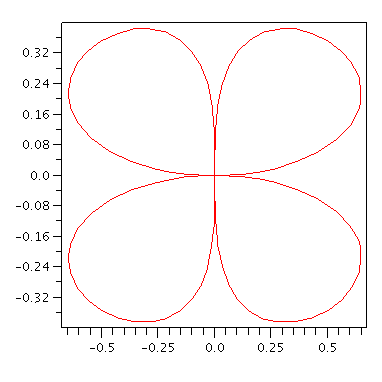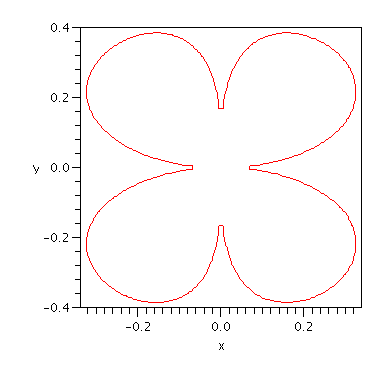
| > |
MATH 392 -- Seminar in Computational Commutative Algebra
Another "black box" Gr"obner basis calculation.
We saw in the lab last Friday that lex Gr"obner bases
apparently can eliminate variables and produce elements
of a polynomial ideal that contain only some of the
variables present in the original polynomials (if there
are such). One place where this might be useful is when
we want to find implicit equations of parametrically defined
curves or surfaces. Here is one such example, which is
even a case where the parametrization involves trig functions:
x = sin(t) cos^3(t)
y = sin^2(t) cos(t)
in the plane.
| > |
| > | plot([2*sin(t)*cos(t)^3,sin(t)^2*cos(t),t=0..2*Pi]); |

We introduce variables s for sin(t), c for cos(t),
and add the algebraic relation s^2 + c^2 - 1 = 0 for all t.
Let's see what happens if we compute a lex Gr"obner basis
for the ideal
< x - sc^3, y - s^2c, s^2 + c^2 - 1>
(lex order with s > c > x > y to try to eliminate s, c )
| > | with(Groebner); |
![]()
![]()
![]()
![]()
![]()
| > | Id:=[x-s*c^3,y-s^2*c,s^2+c^2-1]; |
![]()
| > | B:=Basis(Id,plex(s,c,x,y)); |
![]()
![]()
![]()
![]()
![]()
![]()
| > |
Note that the first element of the Gr"obner basis does contain only x,y
terms, as we hoped! The variety defined by that polynomial also looks
right!
| > | with(plots): |
| > | implicitplot(B[1],x=-1..1,y=-1..1,grid=[200,200]); |

| > |